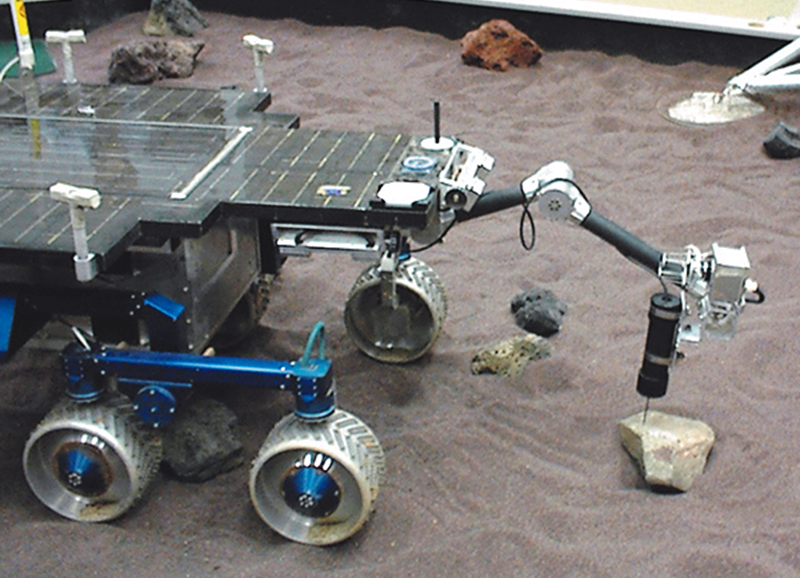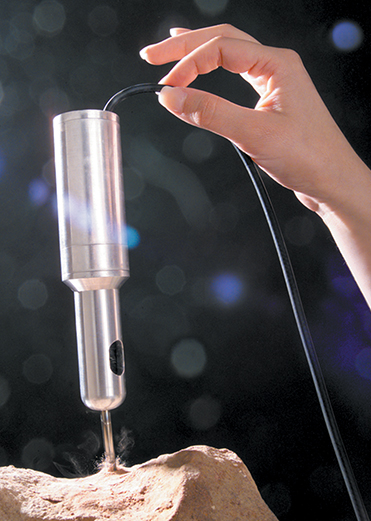
Cybersonics--Tapping Into Technology
Just this year, NASA successfully landed the NEAR (Near Earth Asteroid Rendezvous) spacecraft on the asteroid Eros as part of a space exploration project. As NASA space exploration expands, the need for revolutionary new technologies increases. A company from northwestern Pennsylvania has stepped up to the plate and delivered an innovative technology with infinite possibilities. Cybersonics, Inc., of Erie, Pennsylvania, with the assistance of Small Business Innovation Research (SBIR) funding from NASA's Jet Propulsion Laboratory (JPL), Pasadena, California, has developed an ultrasonic drill with applications ranging from the medical industry to space exploration.
The drill, which has the ability to take a core sample of the hardest granite or perform the most delicate diagnostic medical procedure, is a lightweight, ultrasonic device made to fit in the palm of the hand. Piezoelectric actuators, which have only two moving parts and no gears or motors, drive the components of the device, enabling it to operate in a wide range of temperatures. Piezoelectricity is the generation of electricity in dielectric crystals (crystals that do not conduct electricity) subjected to mechanical stress.
There are three main sections to the drill: an ultrasonic actuator, a free-mass resonator, and a drill stem. The device operates when vibrations from the ultrasonic actuator excite the free-mass resonator. Acoustic energy in the resonator is transferred to the drill stem and then to the surface of the interface, where the interface is excited past its ultimate strain, and fractures.
The most remarkable aspect of the drill is its ability to penetrate even the hardest rock, such as basalt, with minimal force application. The ultrasonic device requires 20 to 30 times less force than standard rotating drills, allowing it to be safely guided by hand during operation. This is an important feature when attempting to drill a core sample in zero gravity, where an astronaut's positioning to the interface is not always optimal. Also, the drill is operable at a level as low as three watts of power, where conventional drills require more than three times this level.
This revolutionary device has a vast array of advantages over traditional drills. For one, the coring bit of the drill creates a hole that is slightly bigger than the bit itself, reducing the likelihood of the drill jamming due to a buildup of accumulated interface material. Another advantage is that the ultrasonic drill bit need not be sharp because ultrasonic vibrations are responsible for the drilling action. The piezoelectric actuators power the drill through the surface without concern of wear. Because the drill can operate without rotation, the core samples can be square, round, or any other desirable shape.
Research members of the Nondestructive Evaluation and Advanced Actuators (NDEAA) team at JPL are currently developing a flight model of the ultrasonic drill, which will have the ability to abrade weathered layers of rock in order to expose pristine surfaces for analysis. NASA hopes to include the flight unit in the Mars 2003 exploration mission.
The JPL team and Cybersonics are also developing an additional prototype drill that is intended to reach meters deep, allowing for a more accurate core sample. The device, named the Ultrasonic-Gofer, will be reeled down to the drilled well, where it will core the ground and upload a sample to the surface. If successful, this device will be included in the Mars 2007 mission.
This exciting technology, which actually began as a device to treat kidney stones, offers an optimistic future for any number of professions. Currently, Cybersonics provides a variety of medical institutions with variations of this technology customized to fit their specific needs. Future applications for the ultrasonic drill are too numerous to name, but include potential applications in rock and soil sampling, medical procedures that involve core sampling or probing, landmine detection, building and construction, and space exploration.

Requiring 20 to 30 times less force than standard rotating drills, Cybersonics' ultrasonic drill has the ability to penetrate even the hardest rock, with minimal force application.

Research members of the Nondestructive Evaluation and Advanced Actuators (NDEAA) team at JPL are currently developing a flight model of the ultrasonic drill, like the one seen here attached to a space rover. NASA hopes to include a flight unit drill in the Mars 2003 exploration mission.













